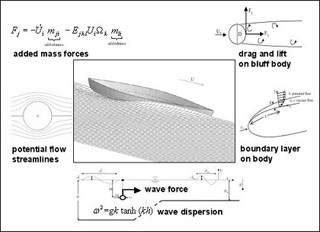
Illustration of some of the tools and concepts of marine hydrodynamics covered in the course, relevant in this case to the design of ships and offshore platform. (Image by Prof. Dick K. P. Yue.)
Instructor(s)
Prof. Dick K. P. Yue
MIT Course Number
2.20
As Taught In
Spring 2005
Level
Graduate
Course Description
Course Features
Course Highlights
This course features a complete set of 22 lecture and 12 recitation notes. In addition, problem sets are available in the assignments section.
Course Description
In this course the fundamentals of fluid mechanics are developed in the context of naval architecture and ocean science and engineering. The various topics covered are: Transport theorem and conservation principles, Navier-Stokes' equation, dimensional analysis, ideal and potential flows, vorticity and Kelvin's theorem, hydrodynamic forces in potential flow, D'Alembert's paradox, added-mass, slender-body theory, viscous-fluid flow, laminar and turbulent boundary layers, model testing, scaling laws, application of potential theory to surface waves, energy transport, wave/body forces, linearized theory of lifting surfaces, and experimental project in the towing tank or propeller tunnel.
This subject was originally offered in Course 13 (Department of Ocean Engineering) as 13.021. In 2005, ocean engineering became part of Course 2 (Department of Mechanical Engineering), and this subject was renumbered 2.20.


